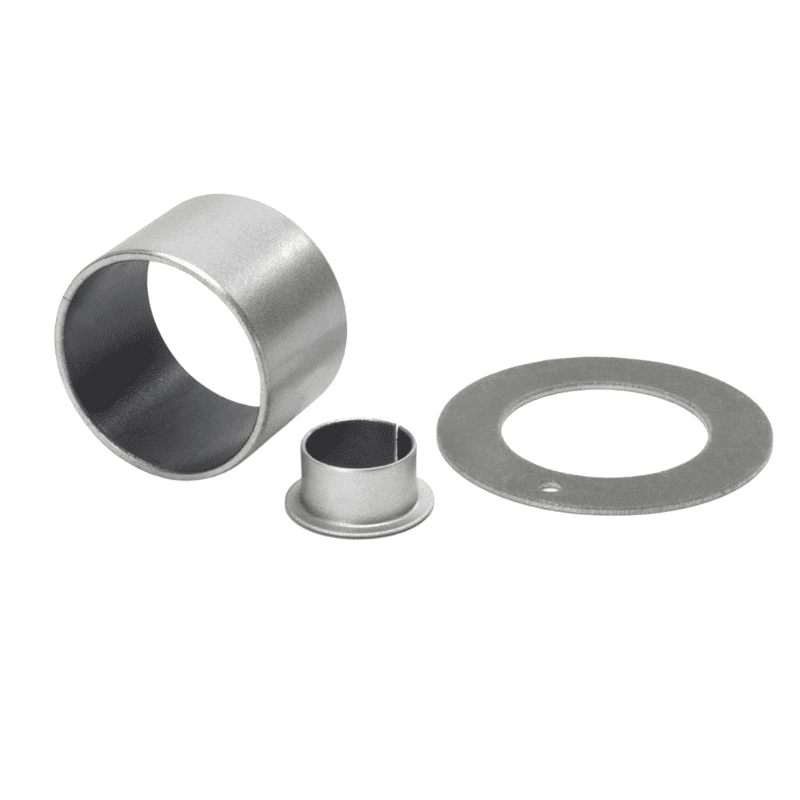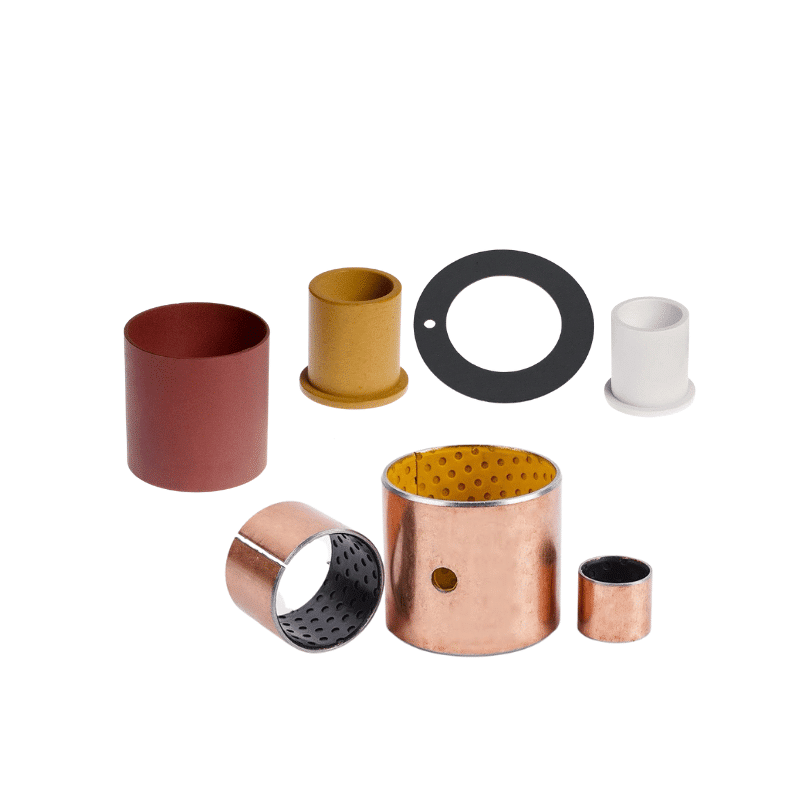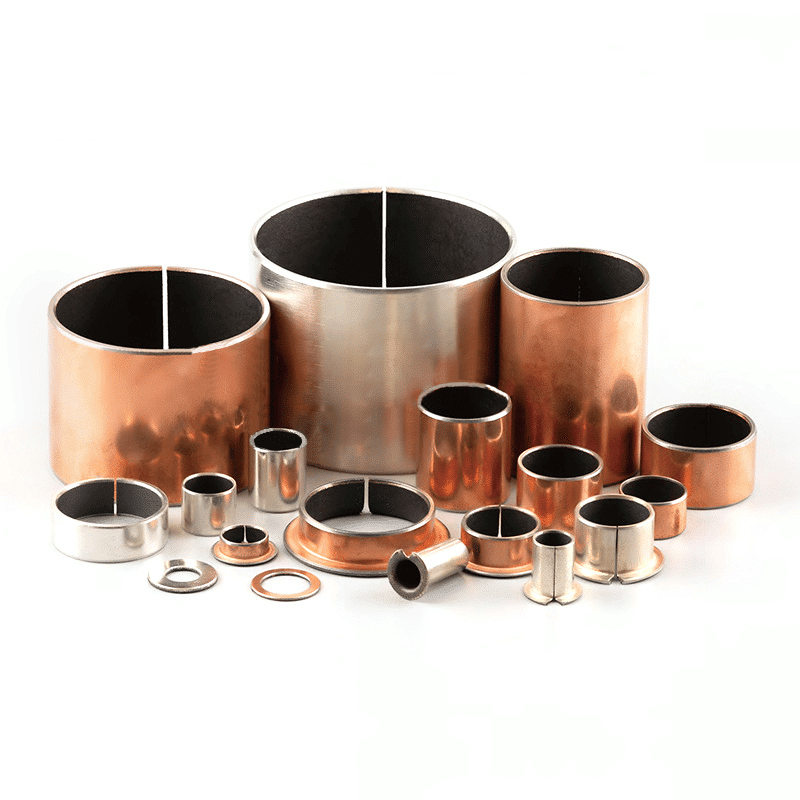Damage patterns of plain bearings
Bearings and Bushings for the Future: Precision and Customization: Our company, in bearing engineering with decades of experience, designs and develops high-precision self-lubricating bronze bearings & plain bushes. We offer a wide array of sliding bearings tailored to meet specific needs. Renowned for our expertise in custom bronze bushing and slide plate solutions, we provide an expansive selection of bushing metal alloys. Contact us today to benefit from unparalleled services at competitive prices.
Damage patterns of plain bearings
Damage patterns of plain bearings
Plain bearings, also known as bushings, are mechanical components that are commonly used in machinery to support rotating or sliding shafts. Self-lubricating bushings, also known as oilless bearings or dry bearings, are a type of plain bearing that do not require external lubrication, as they have a solid lubricant embedded in the material.
Reliable Plain Bearing-
Supplier
Made in China, Contact us to start your import process today! Get the Best in Plain Bearings – Made in China.
professional
Plain Bearings Manufacturer
Our plain bearing manufacturing company in China offers top-quality self-lubricating bushings that are ideal for industrial and machinery applications. Reach out to us today and discover why we’re the best choice for your bearing needs.
quality plain bearings
Focus
Our China-based plain bearing manufacturing company offers a range of self-lubricating bushings that are perfect for wholesalers and distributors seeking quality products for their local markets.
self-lubricating
custom size
As a leading plain bearing manufacturer in China, we offer a range of self-lubricating bushings that are perfect for wholesalers and distributors seeking quality products for their local markets. Contact us to start your import process today!

Download the Plain bearing Catalog now for free
Plain bearings, also known as sleeve bearings, bushings, or journal bearings, are a type of bearing that is commonly used in machinery to support rotating shafts. These bearings are typically made of a low-friction material, such as brass, bronze, or plastic, and are designed to provide a low-friction interface between the rotating shaft and the stationary bearing surface.
We manufacture plain bearing bushing tailored to your individual needs.
Damage Patterns Of Plain Bearings
However, self-lubricating bushings can still experience wear and damage over time due to a number of factors. Here are some common damage patterns that can occur in self-lubricating bushings:
Surface wear: Over time, the surface of the self-lubricating bushing can wear down due to friction with the shaft or other components. This can result in increased clearance between the bushing and the shaft, which can lead to increased noise, vibration, and reduced performance.
Cracking: Self-lubricating bushings can crack due to excessive loads or shock loads. This can occur if the bushing is not properly designed for the application or if the operating conditions are beyond the bushing’s capacity.
Deformation: Excessive heat or loading can cause self-lubricating bushings to deform or change shape, which can lead to misalignment or reduced performance.
Corrosion: If the self-lubricating bushing is exposed to harsh environments, such as high humidity or corrosive chemicals, it can experience corrosion or chemical attack. This can lead to increased wear, reduced performance, and even failure of the bushing.
Extrusion: Under high pressure, self-lubricating bushings can deform and extrude through small gaps or clearances. This can lead to damage to other components in the machinery, and can also result in increased clearance between the bushing and the shaft.
To avoid these damage patterns, it’s important to choose the right type of self-lubricating bushing for the application and to ensure that the bushing is properly installed and maintained. Regular inspection and maintenance can help identify and address any potential issues before they lead to failure or damage.
Detecting deformations in plain bearings
Detecting deformations in plain bearings, including self-lubricating bushings, is important to prevent damage and failure of the bearing and the machinery it supports. Here are some methods for detecting deformations in plain bearings:
Visual Inspection: A visual inspection of the bearing can often reveal signs of deformation, such as visible warping or cracking. This can be done during regular maintenance or when a machine is shut down for repair.
Dimensional Measurements: Measuring the inside and outside diameters of the bearing can reveal changes in shape that may indicate deformation. This can be done with tools such as micrometers, dial gauges, or laser measurement devices.
Vibration Analysis: Vibration analysis can be used to detect changes in the frequency or amplitude of vibrations in the machinery, which can indicate deformation of the bearing. This can be done with specialized equipment that measures and analyzes vibrations in the machine.
Acoustic Emission Analysis: Acoustic emission analysis is a non-destructive testing technique that can detect changes in the sound emitted by the bearing or the surrounding machinery. Changes in the acoustic emission signal can indicate deformations in the bearing.
X-ray or Ultrasonic Inspection: X-ray or ultrasonic inspection can be used to detect internal deformations in the bearing, such as cracks or delamination. This can be done with specialized equipment that uses X-rays or ultrasonic waves to detect changes in the material.
In general, a combination of these methods can be used to detect deformations in plain bearings, depending on the specific application and the availability of testing equipment. Regular inspection and maintenance can help identify deformations early, before they lead to significant damage or failure of the bearing and the machinery it supports.
How we solve the Damage Patterns of Plain Bearings
The approach to solving damage patterns in plain bearings, including self-lubricating bushings, depends on the specific damage pattern and the root cause of the problem. Here are some general approaches to addressing common damage patterns in self-lubricating bushings:
Surface wear: To address surface wear, it may be necessary to replace the bushing or shaft, or to re-machine the surfaces to restore proper clearance. It may also be necessary to adjust the operating conditions or lubrication to reduce wear in the future.
Cracking: If a self-lubricating bushing is cracking due to excessive loads or shock loads, it may be necessary to redesign the component to better suit the application. Alternatively, it may be necessary to adjust the operating conditions or lubrication to reduce stress on the bushing.
Deformation: To address deformation in a self-lubricating bushing, it may be necessary to replace the bushing or shaft, or to adjust the operating conditions to reduce heat or loading. Redesigning the component to better suit the application may also be necessary.
Corrosion: If a self-lubricating bushing is experiencing corrosion, it may be necessary to replace the component with a more corrosion-resistant material or to implement measures to protect the component from the corrosive environment.
Extrusion: To prevent extrusion damage in self-lubricating bushings, it may be necessary to choose a bushing with a higher load capacity or to increase the clearances between the bushing and other components. It may also be necessary to adjust the operating conditions or lubrication to reduce the potential for high pressure.
In general, regular inspection and maintenance of machinery can help identify potential issues with plain bearings before they result in significant damage or failure. Proper installation and use of the correct type of bearing for the application can also help prevent damage patterns from occurring in the first place. When damage patterns do occur, it’s important to identify the root cause and take appropriate action to prevent the problem from recurring in the future.
Design and Construction of Plain Bearings
In this article, we will explore the basics of plain bearings, including their design, construction, and applications. We will also discuss the advantages and disadvantages of plain bearings, as well as the common types of damage that can occur in these bearings and how to prevent and address these issues.
Design and Construction of Plain Bearings
Plain bearings consist of two main components: the bearing itself and the shaft that it supports. The bearing is typically made of a low-friction material, such as brass, bronze, or plastic, and is designed to provide a low-friction interface between the rotating shaft and the stationary bearing surface.
The shaft, on the other hand, is the rotating component that is supported by the bearing. The shaft is typically made of a hard, durable material, such as steel, and is designed to transmit torque from the motor or other driving source to the machine components that are connected to the shaft.
The design of the plain bearing is critical to its performance and longevity. The bearing must be designed to support the load of the rotating shaft, as well as any additional loads that may be imposed on the machine during operation. The bearing must also be designed to minimize friction and wear, and to operate with minimal maintenance and lubrication.
There are several different types of plain bearings, including sleeve bearings, flanged bearings, and thrust bearings. Sleeve bearings are the most common type of plain bearing and consist of a cylindrical sleeve that fits over the shaft. Flanged bearings are similar to sleeve bearings, but have a flange that extends out from the bearing to provide additional support. Thrust bearings, on the other hand, are designed to support axial loads and are typically used in applications where there is a significant amount of thrust force.
Saving costs with plain bearings
In today’s economy, businesses are constantly looking for ways to reduce costs and increase profitability. One way to achieve this is by using plain bearings instead of more complex bearing systems. Plain bearings are a simple, cost-effective solution for many applications and can help businesses save on maintenance, repair, and replacement costs.
Plain bearings, also known as bushings, are a type of bearing that uses a sliding or rubbing motion between the bearing and the shaft or housing to provide support and reduce friction. They are typically made of low-cost materials such as bronze, plastic, or composite materials, making them a cost-effective alternative to more complex bearing systems that require specialized components or maintenance.
One of the key benefits of using plain bearings is their durability. Because they do not rely on rolling elements like ball bearings or roller bearings, they are less prone to wear and tear and can last longer in high-load applications. This means that businesses can save money on replacement costs over time, as they will not need to replace the bearings as frequently.
Another advantage of plain bearings is that they require less maintenance than other types of bearings. With ball bearings and roller bearings, regular lubrication is necessary to prevent friction and wear. In contrast, plain bearings can operate without lubrication in some applications, and they generally require less frequent lubrication than other bearing types. This can save businesses both time and money on maintenance tasks.
In addition to their durability and low maintenance requirements, plain bearings can also be a cost-effective solution for businesses that need to meet specific performance requirements. For example, plastic or composite plain bearings can be designed to provide low-friction or high-load capabilities, making them a versatile option for a wide range of applications.
Finally, plain bearings are also easier to install than other bearing types, which can further reduce costs. Because they do not require precise alignment or specialized installation tools, they can be quickly and easily installed by maintenance personnel. This can save businesses both time and money on installation and repair tasks.
In conclusion, using plain bearings can be a smart way for businesses to save costs while still maintaining high levels of performance. With their durability, low maintenance requirements, and versatility, plain bearings can be a cost-effective alternative to more complex bearing systems, helping businesses reduce their overall costs and increase their profitability.
Advantages of Plain Bearings
Plain bearings offer several advantages over other types of bearings, including their low cost, simple design, and ease of maintenance. Because they do not have rolling elements, such as balls or rollers, plain bearings are less prone to wear and failure due to surface fatigue, which can be a common problem with rolling-element bearings. Plain bearings also provide a low-friction interface between the shaft and the bearing, which can reduce energy consumption and improve overall efficiency.


Damage Patterns and Prevention in Plain Bearings
One of the common problems that can occur in plain bearings is surface wear. Surface wear occurs when the bearing surface becomes worn due to contact with the rotating shaft or other components. This can be caused by a variety of factors, including high loads, misalignment, or insufficient lubrication.
To prevent surface wear, it is important to choose the correct bearing material and to ensure that the bearing is properly lubricated. Regular maintenance and inspection can also help identify and address surface wear before it becomes a significant problem.
taxation planning
Eiusmod tempor incididunt ipsum ut labore dolore magna aliqua. Ut enim minim veniam duisy ipsum sed quis.

Solutions For Every Industry
Searching for Dependable Bushing Solutions? viiplus Has What You Need.

Design Guides, Materials
Bushing design, Comprehensive design manuals covering a range of self-lubricating materials used in all of viiplus’s manufacturing processes.

Technical Guides
Manufacturing On Demand, Technical Guides For Machining Design. Discover the latest in metal alloys, materials, and design tips for manufacturing custom machined and self-lubricating bearing parts.

Get Instant Quote
To receive your instant quote, simply upload your drawing file and choose your production process & bushing material.

Prototyping, Place Order
After you place your order, we will start the production process. You will receive updates when your order has completed production and is ready to be dispatched.

Receive Your custom Parts
We provide precision-inspected high-quality parts, packing lists and documents, and delivery tracking.


